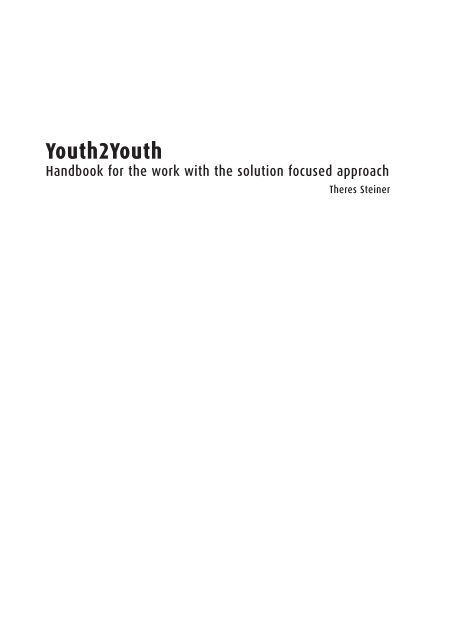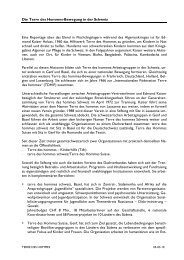Youth2Youth - Terre des Hommes Schweiz
Youth2Youth - Terre des Hommes Schweiz
Youth2Youth - Terre des Hommes Schweiz
You also want an ePaper? Increase the reach of your titles
YUMPU automatically turns print PDFs into web optimized ePapers that Google loves.
<strong>Youth2Youth</strong>Handbook for the work with the solution focused approachTheres Steiner
ImpressumPublisher: terre <strong>des</strong> hommes schweizLaufenstrasse 12, Postfach, CH-4018 Baselinfo@terre<strong>des</strong>hommes.chwww.terre<strong>des</strong>hommesschweiz.chAuthor: Theres SteinerEditor: Irene BushIllustrations: John KilakaLayout: Homberger und Minet, BaselPrint: Schwabe AG, Muttenz
ContentsIntroduction 5Section 1: The solution focused approach 9Section 2: SFA in practice 39Section 3: Monitoring and Evaluation 75Interview with Theres Steiner 85Acknowledgements 90Illustrations: John Kilaka
Introductionterre <strong>des</strong> hommes schweiz has an institutional history in working withyouth and was amongst the first organisations to promote psychosocialsupport for children affected by HIV/Aids in sub-Saharan Africa. The terre<strong>des</strong> hommes schweiz initiated Humuliza project of Tanzania is known forits innovative approach.Since 2001, the youth-led project “imagine” of terre <strong>des</strong> hommesschweiz organises workshops and a festival against racism in Switzerland.With “imagine international” the concept of youth-led events and advocacyfor relevant issues has been expanded to Brazil, Colombia and Kenya.With the strategic decision to reinforce the cooperation with sub-Saharan Africa terre <strong>des</strong> hommes schweiz consequently followed-up theknow-how, experiences, as well as best practices in the area of psychosocialsupport and youth participation. In cooperation with <strong>Terre</strong> <strong>des</strong><strong>Hommes</strong> Germany terre <strong>des</strong> hommes schweiz launched this pilot programto strengthen the social energy of children and youth.terre <strong>des</strong> hommes schweiz has elaborated a concept to <strong>des</strong>cribe ownstandards for psychosocial support. These standards are matched by theadaptable, practical and resource-orientated solution focused (SF) approach,respecting the cultural identity and background of the people. SFstands for a mindset promoting the expertise of the people themselves.The solution for challenges doesn’t come from the outside. The answerto problems has to come from within, whereas the role from the outsideis to recognise the capacity of the people facing problems by guidingthem to define their goals step by step. With this attitude of respectingstrengths and resources of each other, people meet at eye-level: youthand adults, counsellors and clients, donors and funded organisations.terre <strong>des</strong> hommes schweiz was very lucky to meet Dr. Theres Steiner, aworldwide recognised expert in the SF approach. She agreed to supportthe program under the condition that it would be solution focused all theway through. This implied that the program would be <strong>des</strong>igned togetherwith youth from the sub-Saharan region and would involve different levelsfrom the staff of the participating organisations.5
The <strong>Youth2Youth</strong> ProgramIn December 2007 terre <strong>des</strong> hommes schweiz and <strong>Terre</strong> <strong>des</strong> <strong>Hommes</strong>-Germany invited six youths, active as volunteers in partner organisationsfrom South Africa, Tanzania and Zimbabwe to share their expertise andneeds in the context they work in. Together with six expert adults fromsub-Saharan Africa and Switzerland they formed a team to develop thecurriculum of the pilot course. The way the program was outlined; therewould be implications for the participating organisations themselves interms of involvement, support, resource allocation and decision making. Astatement of commitment and valuable contributions were made by thedirectors to refine the focus and planning of the <strong>Youth2Youth</strong> program.From there on, the outline of the pilot course was set with threemodules taking place in different countries from 2008–2009. In-betweenthe 5-day modules participants implemented what they had learned andcascaded their knowledge to peer-learners.Now in 2010, with the pilot course completed, 20 practitioners succeededand are certified “Practitioners of the solution focused approach”.The impressing success of the pilot course included the integrationand participation of staff members from different levels in the organisations,as well as a participative development of the course and ongoingadaption to the needs of the participants. Regional working proved tobe very valuable and inspiring for the participants from four differentcountries from Eastern and Southern Africa. The success reported byorganisations and participants met the expected results and even wentbeyond. In an interview for the evaluation one of the youths of the pilotcourse resumed: “I am very honoured. This course has improved me asa person. I am steps ahead and I am very grateful.” Another youth, askedabout the impact in communities, stated: “The youth with SF skills canstart building their society. They get roles in the community. The societyrealises that youth is very important for the society. We discover a shiftof perspectives. We are bridging the general community together.”In October 2009 a replication course with 27 new participants started.Some of the participants in this course had been peer-learners tothe first course; two organisations are new to this program. It is our aimto africanise SF by adapting it to the context of the different countries6
and organisations involved. At the same time, we would like to establisha kind of quality insurance for solution focused interventions. This littlebooklet is a small step towards this goal. It resumes the mindset, toolsand exercises of the three modules. It’s not a manual that tells you stepby step how to facilitate a group.“How will you know it was worthwhile to come?” or: “What needsto happen during the workshop, so that you know it was helpful to you?”These and similar questions stand at the beginning of SF-workshops. AnSF facilitator needs to be authentic, open, flexible, and have a good perceptionto match his or her knowledge and understanding of SF with theneeds of each specific group he or she is working with. The <strong>Youth2Youth</strong>facilitators are trained to take the concerns of individuals and groupsserious enough to <strong>des</strong>ign the workshop according to their needs. Thisbooklet will be helpful for them to remember the different tools that willguide and support them in this task.Irene Bush, Project Coordinator <strong>Youth2Youth</strong>If you are interested in SF-trainingsin the Sub-Saharan region, please contact:i.bush@terre<strong>des</strong>hommes.chto link you up with our partner organisations.7
What kind of solution can you think of ?
1. The solution focused approachIntroductionThe Solution Focused (SF) approach was developed by Steve de Shazerand Insoo Kim Berg as a therapy model. The two lived in Milwaukee, USA.Insoo was originally Korean, Steve American. They worked mainly withAfrican-Americans living in very poor conditions.They worked with mainly poor clients with many problems: unemployment,substance abuse, violence, and illnesses.Steve and Insoo realised that a problem solving approach did not workin such complex situations. They started to focus on the strength of theclients. This meant focusing on the things that people are already doingwell. It also meant focusing on the skills and ideas that people alreadyhad. Steve and Insoo also found it helpful to focus on the exceptionsthat means on time when the problem is less severe or doesn’t show upat all. This is when the <strong>des</strong>ired behaviour or circumstance is happeningalready, maybe only a tiny little bit.Exceptions are times whenthings are different to usual. In SFthis means looking at the timeswhen the problem is not presentor less impedimentary. Whenthings are going better than usual.They called their model Solution Focused (SF). Their model was firstdeveloped for counselling. Now a day it is used in many different contextslike schools, business and youth organisations, prisons etc.9
SF works with very specific ideas about human beings and theway changes occur:1. Every human being has strengths and resources.2. Nothing is always the same, change is inevitable (will always happen).3. If something is working do more of it. If it is not working dosomething else.4. Small steps can lead to big changes.5. The solution is not necessarily directly related to the problem.6. No problem happens all the time. There are always exceptions thatcan be used.7. The future is created and negotiable (it is not fixed).SF is very simple in its method. At the same time it needs a lotof hard work and persistency to build up the solution focusedmindset. It can be learned by anybody:1. Who is willing to really listen to the client,2. Who is interested in what the client wants to achieve,3. Who is future oriented,4. Who is respectful to everybody,5. Who believes that every person has strengths even if they may notshow up in that moment,6. Who acknowledges that everybody has his or her own way toimprove, and that the client is the expert for her or his change,7. Who realises and appreciates improvements, as tiny as theymight be.SF consists mainly in asking helpful questions, finding exceptions andhelping the client to shape his or her future in the <strong>des</strong>ired way.SF is very much focused on the doing level. This means focusing on theperson’s behaviour. A core belief is that feelings and thoughts are alwaysrelated to the things an individual does. For example if somebodywould like to cheer up we will ask the question: “What did you do thelast time your mood was a little bit better?” This is different to askingabout thoughts or feelings. When we ask about “doing” we are askingabout behaviours that we can actually see and <strong>des</strong>cribe. So for example10
the person could answer the question by saying “I went for a walk” or“I went out with my friends” or “I washed my face”.Expertise is the knowledge andskills that we have that come outof our own experience and learningabout our lives.SF is based on the expertise of the client. SF is interested in thingswhich worked out well for the client and encourage her or him do tomore of what works.SF does not give advice to clients. Instead it empowers and encouragesthe client to use her or his resources and do more of what worked.Advice is when we tell someonehow to do something.The model is really simple. It needs training and an ongoing learning processin its applications (how to make it practical). It is much easier to givean advice than to work out together with the client what is specificallyhelpful for exactly this unique individual. That’s why we say:SF is simple but not easy!SF-mindset“Show me and I will not remember,Tell me and I will forgetInvolve me and I will understand”Red Indian WisdomThe solution focused approach is a way of thinking. It is important tounderstand that the mindset is the most important and at the same timethe most powerful part of it.11
Small steps can lead to large changes.13
Problem solving approach versus solutionfocused approach“Two prisoners look out through barsOne sees mudAnd the other sees stars”The SF approach is different to the problem solving approach. Here aresome points about how they differ.Using a problem solving approach:1. Gather as much information as possible about: the difficulties,mistakes, causes, feelings, and abnormal behaviour.2. The findings are assessed and analysed (this is called problemanalysis).3. Based on the assessed findings the person in charge comes up withinterventions, which might have a positive influence.4. The person in charge (supervisor, group leader, therapist etc.) givesthe order about what to do. The competence for the solution iswithin the counsellor or youth leader who has the specific knowledge.The client/youth has only his or her intuition. The client/groupis advised.Using the solution focused approach:1. Ask what is important in the client’s life.2. Ask what the client can do well. Find the client’s resources.3. Ask about the goal.4. Ask about little past or current successes that are related to thegoals. Find positive exceptions.5. Ask about the possibility of repeating these successful steps.6. Ask about the first/ or next little step in order to reach the goal.(scaling question)7. Ask the client to go and try this out.8. Ask the client next time when you see her/him what has workedwell. Compliment him or her of what went well. Get as many detailsas possible how the client did, and what went well.14
The best way to find a solution is within the client/ group. The client/ grouphave the specific knowledge. The helper has communication skills and canobserve carefully what works. The client/group and the helper construct(build together) new ideas while talking. In the SF approach you are theexpert for helpful questions and the way the interview goes. The client/group is the expert of the specific solution.As expert of the interview you are interested in:• What has to be achieved, what is the wish and how does the client/group want to achieve this goal? (Goal, dynamic of the situation)• What can the client/group do? (Resources)• What is the first step? (Doing)The energy for development emerges from:• A problem or a <strong>des</strong>ire• A vision in the future, a goal• The careful awareness of progress, as small as it might beSF-tools: WH-questionsWhat needs to happen that you can say our talk has been helpful to you?What would you say is the most important topic?What was the most helpful thing you did to overcome the criticalsituation?What would your best friend say was helpful?What else?What tells you are on the scale on 5?Where were you when things went better?Where did you get this helpful idea from?Where do you need to be/to feel calm?Where would you say are you on the scale from 1–10?When is the best time to do these kinds of things?When did you discover keeping silent was helpful?15
When did the good time start?When was it the last time you have been as courageous as that?How did you find out that you could do these things in this manner?How come you are confident about this?How did you do that?How did you get started?Who observed this good situation?Who gave you this idea?Who would you say could be helpful?The not knowing positionIt is a mistake to think if somebody tells you “I am happy” or “sad” thatyou know what this means. Happiness or sadness is always experiencedin a very individual way. Until we ask, we do not know what the personmeans by the word happy or sad. In the SF approach it is a virtue (goodthing) not to understand too quickly. The not knowing position is oneof the most powerful tools we have, but it is quite difficult to achieve.Skills for not knowing:• Listen carefully• Echoing (repeating) the client’s key words• Summarise and paraphrase• Affirming the client’s perception (point of view)• Use open questions• Use of silence (being present without saying anything)• Notice client’s non verbal behaviour (the way she sits, or moves,or the way he changes his face)Affirming in this context means: we help the client realise that we heardher or his point of view. For example: I understand you work best whenyou can do things together with others is that right?16
Helpful questions to ask1. You must have a good reason. Examples:• You must have a good reason not to show up• You must have a good reason not to have done what you were told• You must have a good reason not to listen to your boss• You must have a good reason not to tell the truthThe answer to these sorts of questions gives you an idea of what isimportant for the clientThe answers represent (show us) the very individual perception of thisperson.2. How is this a problem for you? Examples:• How is this a problem for you not to have succeeded?• How is this a problem for you that you do not get the same goodresults as your fellows?• How is this a problem for you that you are not estimated by theyouth?• How is this a problem for you that youth is not listening to you?3. How is this helpful? Examples:• How is it helpful for you not to tell the truth?• How is it helpful to run away?• How is it helpful to want to commit suicide?4. What difference does it make? What difference does itmake when you behave like that? Examples:• What difference does it make when you are aggressive?• What difference does it make when you shout?What about shouting is important?• Tell me again what difference does it make when you shout?• What difference does it make when you take drugs?17
5. What tells you that you can do that?Examples:• What tells you that you can be on time?• What tells you that you can do well in your work?• What tells you that you have everything ready for the meeting?6. Questions about solutions or ideas. Examples:• What are your plans?• What thoughts cross your mind?• What kind of solution can you think of?• What do you think your parents or your teachers are expecting?• What do you assume what kind of advantages will you have supposeyou are going to ignore the teachers or the parents command?Scaling questionsImagine a scale from 1–10: 10 stands for the moment when the goalmentioned in the conversation is met. 1 is just the opposite to that ortimes when things were at their worst. Once you have explained this tothe client you can ask “On this scale of 1 to 10, where would yousay you are right now?”Make sure you always define very carefully the ten. The definition of the1 is easy as it is just the opposite of 10.Once you have understood where the client is on this scale,you can ask different questions:• Suppose you moved one step up from where you are now, what willyou be doing then, what you are not doing right now?• What else will you be doing?• What will your best friend notice as a difference when you havemoved one step up?18
It is important to get a very clear and detailed <strong>des</strong>cription of how thingswill look one step up before you ask how the client will move to that level.Remember to focus on doing – in other words “What will you be doingif you moved up one step?”or “What would it look like if you moved upone step?” or “What would other people see you doing differently if youhad moved up one step?”This procedure has lots to do with the respect towards your client. Ifthe client knew how to move from one level to the other for sure she/he would do it. First it needs this detailed <strong>des</strong>cription of the next levelin order to enable the client to come up with ideas on how to move up.Here are some other helpful scaling questions:• On a scale from 1–10 where would you say are you right now?• What tells you that you are at a 6?• What difference is there between 5 and 6?• What can your parents observe you doing when you are at 6, whatthey could not see when you were still at 5?• What needs to happen that you can stay on a 6? What can you do?• What can others do to help you?• Suppose I was going to ask your boss, where do you think he wouldsay you are on the scale?• Suppose you are 1 point higher, what will be different in your life?• What would be different between you and your boss?• What would be different between you and your peers?• What would be different between you and your friends?19






